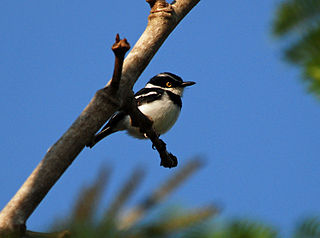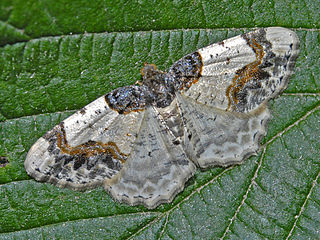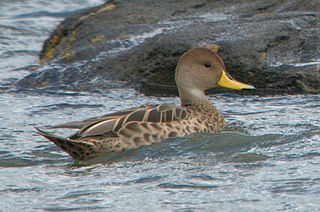
The purple starling, estorninho azul(argentina, peru, colombia), melro metálico (brazil) also known as the purple glossy starling, is a member of the starling family of birds.

The brown-throated wattle-eye, also known as the common wattle-eye or scarlet-spectacled wattle-eye, is a small, insectivorous passerine bird. The wattle-eyes were previously classed as a subfamily of the Old World flycatcher family Muscicapidae, but are now usually separated from that group.

The common footman is a moth of the family Erebidae. The species was first described by Johann Leopold Theodor Friedrich Zincken in 1817. It is distributed throughout Europe and east through the Palearctic to Lake Baikal.

Smerinthus ocellatus, the eyed hawk-moth, is a European moth of the family Sphingidae. The species was first described by Carl Linnaeus in his 1758 10th edition of Systema Naturae.
The Tasman starling was described in 1836 by John Gould as a species which occurred on both Norfolk Island and Lord Howe Island. In 1928 Australian ornithologist Gregory Mathews recognized that the plumage of the race from Lord Howe Island was much browner and more greyish than the plumage of the Norfolk Island race and split the species into two forms, the Norfolk starling, and the Lord Howe starling. Both subspecies are now extinct, thus so the species.

The Christmas imperial pigeon or Christmas Island imperial pigeon, also known as Black imperial pigeon, Dusky imperial pigeon, Wharton's imperial pigeon, or burong pergam, is a large imperial pigeon endemic to Christmas Island in the northeastern Indian Ocean. It has an overall grey-blue colouration, and juveniles are duller than adults. It makes a soft purring coo sound and a deeper whoo sound comparable to a cow mooing. It lays one glossy white egg per brood, and is possibly somewhat colonial.

The black tinamou is a species of ground bird found in humid foothill and montane forest in the Andes of South America.

The black arches or nun moth is a small Palaearctic moth. It is considered a forest pest.
The Ethiopian white-footed mouse or white-footed stenocephalemys is a species of rodent in the family Muridae. It lives in Ethiopia and Eritrea. Its natural habitats are tropical moist montane forest and tropical high-altitude shrubland.

The island bronze-naped pigeon, also known as the São Tomé bronze-naped pigeon or São Tomé pigeon, is a species of bird in the pigeon family, Columbidae. It is endemic to the Gulf of Guinea, where it is found on the islands of São Tomé, Príncipe, and Annobón. It inhabits rainforest, secondary forests, and plantations at elevations of up to 1,668 m (5,472 ft), although it is more common at lower elevations. A small, darkish pigeon, it has a total length of 28 cm (11 in). Adult males have slate-grey heads and upper backs, blackish-grey wings, backs, and tails, buffy-white throats, ashy-grey breasts and bellies, and rufous vents. The back of the neck and upper back are glossy pink or green, while the wings have a green tinge to them. Females are similar, but have browner undersides, duller and less glossy upperparts, and more rusty-orange outer tail feathers.

The eastern black-headed batis is a passerine bird in the family Platysteiridae from eastern Africa. It was formerly treated as conspecific with the western black-headed batis.

The fiery minivet is a species of bird in the family Campephagidae. Its range includes Thailand, Malaysia, Indonesia and the Philippines. Its natural habitats are broadleaf, secondary and coastal forests. It is threatened by forest clearance and has been assessed as near-threatened by the International Union for Conservation of Nature (IUCN).

Ligdia adustata, the scorched carpet, is a moth of the family Geometridae.

Caradrina morpheus, the mottled rustic, is a moth of the superfamily Noctuoidea. The species was first described by Johann Siegfried Hufnagel in 1766. It is found across the Palearctic from northern Europe to Siberia, Amur and Korea. Also in Armenia and Turkestan. It was accidentally introduced on both the east and west coasts of Canada and is so far reported in the east from New Brunswick to Ontario, and in the west from British Columbia.

Noctua orbona, the lunar yellow underwing, is a moth of the family Noctuoidea. It is found in the Palearctic.

The Chilean pintail, also known as the golden peck duck or brown pintail, is a subspecies of the yellow-billed pintail, a duck in the dabbling duck subfamily Anatinae. Its local names are pato jergón grande, pato maicero and pato piquidorado in Spanish, and marreca-parda or marreca-danada in Portuguese.
Blepharomastix glaucinalis is a species of moth in the family Crambidae. It was described by George Hampson in 1917. It is found in Bolivia.
The Elizabeth duck is a breed of domestic duck, originating in Australia. They were developed as a small, fast growing meat breed in 1972 by Lance Ruting in Merrylands, New South Wales and named after his wife, Ann Elizabeth Ruting. They are presently bred in Australia and New Zealand, but are not widely available and classified as endangered by the Rare Breeds Trust of Australia.
Pilocrocis hypoleucalis is a moth in the family Crambidae. It was described by George Hampson in 1912. It is found in Mexico (Tabasco), Panama and Jamaica.
Onebala probolaspis is a moth in the family Gelechiidae. It was described by Edward Meyrick in 1929. It is found in South Africa.













